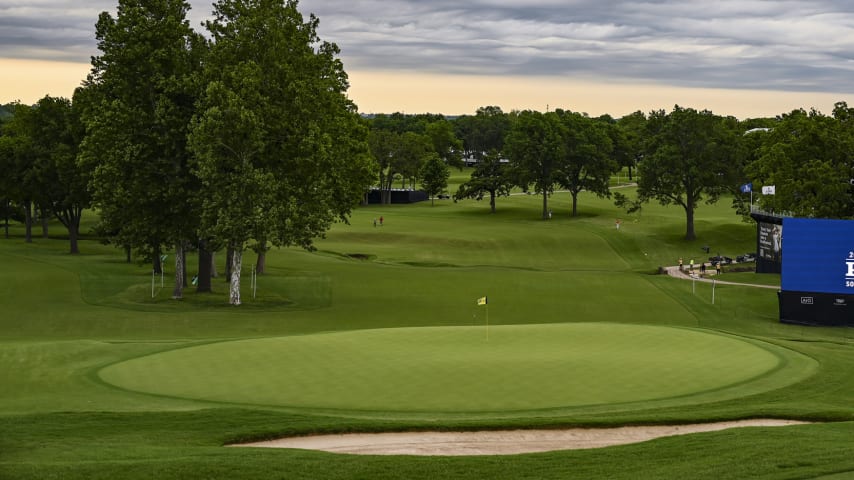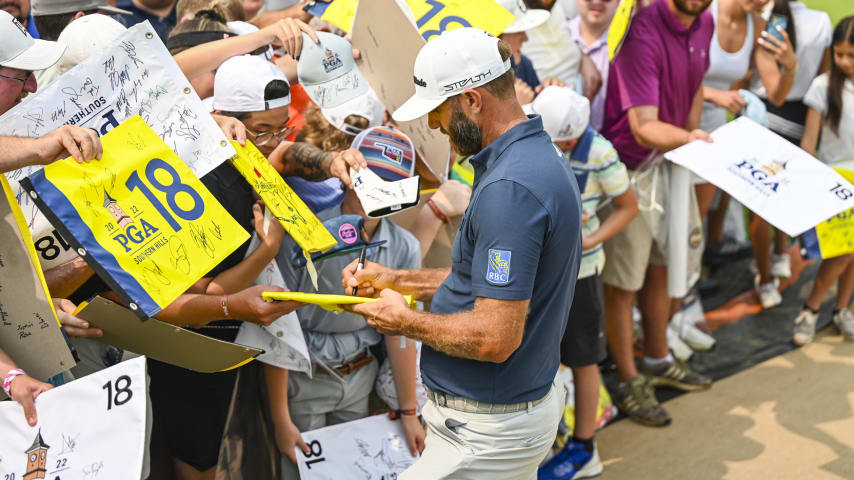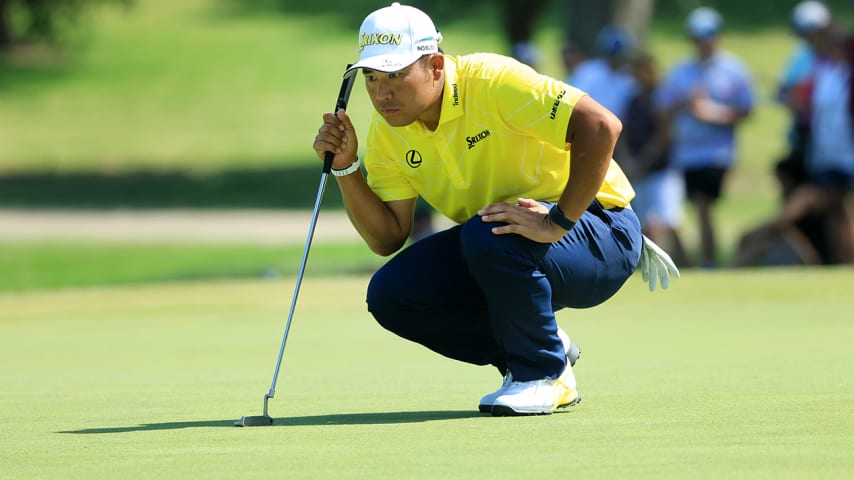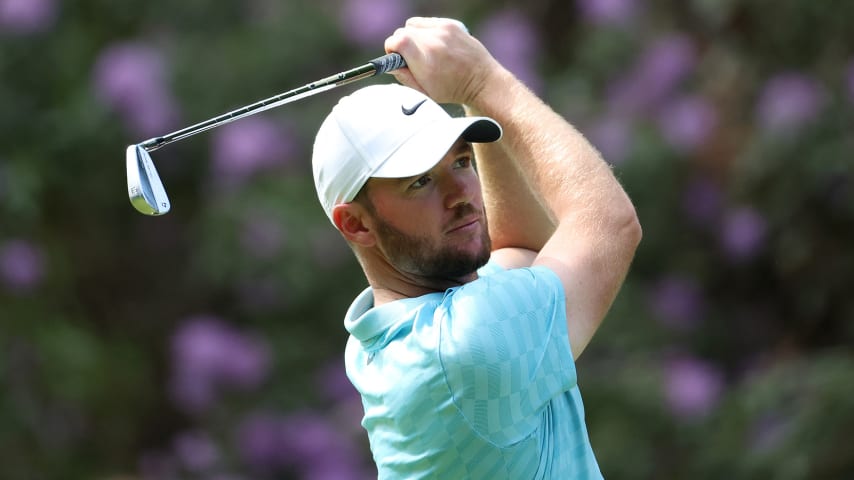Nine Things to Know: Southern Hills Country Club
10 Min Read

Written by Jim McCabe
His invincibility was shattered there with a tinge of shock in 2001.
His aura was rekindled there with pulsating precision in 2007.
The man: Tiger Woods. The place: Southern Hills Country Club in Tulsa, Oklahoma.
Anticipation is ripe for a return to Southern Hills and the 104th PGA Championship. Gil Hanse has restored this Perry Maxwell gem, and now Woods at 46 returns to the site of disappointment (2001 U.S. Open) and triumph (’07 PGA Championship) in the prime of his career.
Here are Nine Things to Know about Southern Hills:
1. Woods has looked both mortal and unbeatable
At the 2001 U.S. Open, Woods was 26 and the winner of four consecutive major championships.
That run ended at Southern Hills. He double-bogeyed his ninth and what turned out to be his final hole Thursday, thanks to torrential rain. Although he had not played a PGA TOUR event in an over-par score for 72 holes since July of 1999, he was 3-over for nine holes.
“If he wins this time,” one adversary quipped, “he’ll be my idol.”
It didn’t get much better. A whisper of a rally (69-69) left Woods at 3 over and T12. He accepted defeat, seemingly convinced he would do better should he get another chance at Southern Hills.
Six years later, that chance arrived at the 2007 PGA Championship, where Woods opened with a modest 1-over 71. He was now 12 over in nine competitive rounds at Southern Hills, dating back to the 1996 TOUR Championship, but a second-round 63 changed everything. It could have been better, but his 18-foot birdie putt at the last ringed the cup. Woods called the round a “62 1/2.”
His two-stroke lead might as well have been a 22-stroke lead. Ernie Els, who had watched his rival bounce back from the ’01 U.S. Open by winning six of the next 25 majors, said he would bet his house on another Woods victory at this PGA. Sure enough, Woods shot 69-69 (the same weekend scores he’d shot in ’01) for an 8-under 272 to beat Woody Austin by two.
Woods had hit 37 of 56 fairways, and 50 greens, and one-putted 25 times.
“It’s pretty much what he’s been doing since 1997,” Trevor Immelman said with a sigh.
Immelman would win the next major, the 2008 Masters, eight months later. Runner-up: Woods.
2. Perry Maxwell put his stamp on it
Perry Maxwell started as a bank vice president who decided he could design a golf course on his dairy farm. He became the awe-inspiring, incredibly prolific “Father of Oklahoma Golf.”
Maxwell did the bulk of his work in that state – by the time he got to Southern Hills in 1935-36, during the Great Depression, he had already designed more than 40 golf courses – but, oh, how he shared his work beyond the borders of Oklahoma. Golf writer Mac Bentley once said of Maxwell that “his genius came from recognizing Mother Nature’s design.”
Others agreed. Dr. Alister MacKenzie partnered with Maxwell to create Crystal Downs in Michigan, Melrose CC in Philadelphia, Oklahoma City Golf & CC, and Augusta National.
Maxwell also helped renovate Pine Valley, Merion and the National Golf Links of America. He joined Marvin Leonard to build Colonial in Fort Worth, Texas; Maxwell and his son, J. Press Maxwell, gave life to Prairie Dunes in Kansas; and premier courses on the campuses of Oklahoma, Ohio State, Michigan, and Iowa State have Maxwell’s fingerprints all of them.
Maxwell cited a trip to Scotland after his first wife, Ray, died in 1919 of appendicitis, as having inspired his design philosophies. He used the topography, embracing contours in fairways, undulated greens, and swells around and on the greens, so-called “Maxwell rolls.”
When he took on Southern Hills, workers stood in line to earn 25 cents an hour, and the job was completed for $100,000. Every hole had twists and bends, bunkers were deep and well placed in prime spots where doglegs began, and a stream snaked through the property. But the most dynamic aspect to Southern Hills were the greens, and Gil Hanse, trusted to the restoration project in 2018, some 66 years after Maxwell’s death, said that hasn’t changed.
3. Gil Hanse restored the luster
When they took on the task of restoring Southern Hills in 2018, Gil Hanse, Jim Wagner and crew had a skeptic eying them from afar: Legendary Oklahoma head pro Jerry Cozby, whose workplace for 41 years had been another Perry Maxwell gem, Hillcrest CC, 45 miles away.
Cozby had his doubts until his oldest son, Cary Cozby, the Director of Golf at Southern Hills, invited him out to see the restoration work being completed. Jerry Cozby loved it.
“This guy (Hanse) gets it,” Jerry Cozby said to his son.
Hanse said he didn’t really get the whole topography thing that Maxwell had going for him until he opened the place up. Too many trees had thickened, too much grass hid the stream, too many fairways had become narrow. Once Hanse’s crew got to trimming back trees and giving more prominence to the stream, they focused on shorter grass and sharper edges along the greens and return the slope and contours to the fairways.
“The classic character of Southern Hills was preserved,” Jerry Cozby told reporters.
4. Three holes stand above the rest
Give him a chair and time and Gil Hanse knows where he’s headed. “No. 10 is a cool hole. It’s probably where I’d camp out,” he told Andy Johnson on The Fried Egg podcast.
It’s 441 yards but will play shorter thanks to a downhill tee shot. A bold tee shot will leave only a short iron into the severely sloped green, but players who get too aggressive off the tee will find the diabolical Southern Hills stream that cuts across the fairway.
Ben Hogan sang the praises of the picturesque par-4 12th, Southern Hills’ signature hole. A 456-yard dogleg left, its fairway slopes right-to-left, pushing balls toward the stream that runs all the way to the green, which is also protected by three daunting bunkers.
Give a guy a one-shot lead in a major on Sunday and the choice of which 18th hole he’d play to protect it, chances are no one would pick Southern Hills’ par-4 18th.
“Killer finish,” said Hanse. “Quintessential finishing hole.”
In seven men’s majors here, only two winners have managed to par the closing hole – Tommy Bolt at the 1958 U.S. Open and Tiger Woods at the 2007 PGA. The 18th will play up to 491 yards, with the second shot uphill to a green that slopes treacherously from back to front. Put it on the wrong spot on the green and good luck two-putting.
In the fourth round of the 2001 U.S. Open, the top three finishers – Retief Goosen, Mark Brooks, and Stewart Cink – all three-putted 18 with victory in their grasp.
5. Hubert Green played under a death threat
Hubert Green was leading the 1977 U.S. Open at Southern Hills by one stroke with four holes remaining when he pulled his tee shot left of the 15th fairway. He tried his best to keep his distance from his caddie, Shayne Grier. The caddie knew why.
Told of a death threat on his life called into the Oklahoma City FBI – an anonymous woman said gunmen would shoot Green at the 15th hole – Green had been given options by USGA President Sandy Tatum and police officers. Green said there was only one option. He’d play on.
In an interview with the Boston Globe in 2007, Grier said Green was keeping his distance so if there was a shooting, the player would be the only target. The gregarious Grier, still a volunteer official with Mass Golf, said he caught up with Green on the 15th and said, “Let’s give them two targets to shoot at.” The levity might have helped. Green recovered from the left rough and made par at 15, then birdied 16 to increase his lead to two. He negotiated a par at 17 and could afford the safe bogey at 18 to win by one over Lou Graham.
6. Frontrunners have held their position
Of the seven men’s majors here – three U.S. Opens, four PGAs – the winner has had at least a share of the lead in each round on five occasions. The exceptions: Dave Stockton at the 1970 PGA opened with 70 and was T-5, two behind Jack Nicklaus and Johnny Miller; and in 2007, Woods had a first-round 71 and was T-23, six behind unheralded Englishman Graeme Storm.
With rare collapses by Nicklaus (76) and Miller (77), Stockton’s second-round 70 got him into a share of first after Round 2, and he led the rest of the way. Woods’ second-round “62-and-a-half” (detailed above) put him in the 36-hole lead and he cruised from there.
Beyond Stockton’s PGA win in ’70 and Woods’ PGA triumph in ’07, these SHCC major winners found the top spot to be quite comfortable start to finish:
* Tommy Bolt at the 1958 U.S. Open, the year he birdied the first and reportedly said, “Who’s going to finish second?”
* Green at the 1977 U.S. Open when he was part of a seven-way tie for first after Round 1, then was all alone the rest of the way.
* Raymond Floyd, owner of arguably the greatest stare in golf history, led by three after opening with 63 and pretty much had it in his pocket all the way at the 1982 PGA.
* Nick Price was tied with Colin Montgomerie after an opening-round 67, but followed it up with a 65 to seize command and eventually won by six at the 1994 PGA.
* Retief Goosen opened with 66 for the solo lead, then shared it after the second, third and fourth rounds – he three-putted from 12 feet at the last Sunday but won a playoff.
Of the seven SHCC winners above, only Stockton is not in the World Golf Hall of Fame.
7. The Babe was in all her glory
When golf returned from the World War II break in 1946, Tusla fans got a treat as the U.S. Women’s Amateur came to Southern Hills. So did “Mrs. Babe Didrikson Zaharias of Denver, Colo., nonpareil of America’s women athletes,” as the AP called her.
You could quibble with the reporter not using her real name, Mildred, but not with the “nonpareil” description. Then 35, The Babe was still a national hero for those two golds and one silver she won in track and field at the 1932 Los Angeles Summer Olympics.
At Southern Hills, her score of 156 in stroke play was four off the medalist’s score, but in five matches Didrikson steamrolled Peggy Kirk (4 and 3), Betty Rucker (4 and 3), Maureen Orcutt (5 and 4), Helen Siegel (3 and 2), and Clara Sherman (11 and 9 in the final) without ever once trailing. It remains the third-largest margin of victory in a U.S. Women’s Amateur final.
It was win No. 5 on a 1946-47 stretch that saw The Babe win 17 consecutive tournaments.
8. The Cozby name is big
If there is a little extra heat at Southern Hills next week, it might be Jerry Cozby’s smile beaming down. For 41 years he was the head pro at Hillcrest CC in Bartlesville, approximately 45 miles north of Tulsa. Beyond morphing into the dean of Oklahoma club professionals, Cozby – who died in 2020 at 79 – and his wife, Karole, raised three boys who are passionate about golf, played at Oklahoma University, and are fully involved in the game.
Chance, the youngest, is Executive Director of the Thunderbirds, host organization to the WM Phoenix Open on the PGA TOUR. Craig, the middle son, is a sales rep for PING in Missouri. And the oldest, Cary, has been at Southern Hills since 1995, going from head professional to Director of Golf. (Jerry Cozby, in 1985, and Cary, in 2016, are the only father-son winners of the PGA Professional of the Year.) Cary gained some fame a few weeks ago when he caddied for Tiger Woods in the latter’s pre-PGA reconnaissance round.
9. Bill Coore and Ben Crenshaw built a nine-hole course
Perry Maxwell built the original tournament course that was later renovated by Gil Hanse.
Bill Coore and Ben Crenshaw built a nine-hole course there in 1990.
How’s that for a world-class lineup?
Land for the nine-hole course had been there since a fire destroyed the club’s horse stables in 1976. With the skeet range and polo field not drawing much interest, the club opted to double down on golf. Leaning on Coore and Crenshaw’s vision, the club built a nine-hole gem with two par 3s, two par 5s, four par 4s – and a whole lot of membership love for these 3,094 yards (3,301 from the tips) where the rating is 71.8 and the slope 126.












